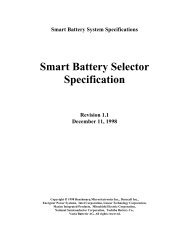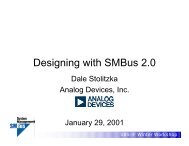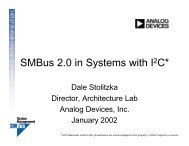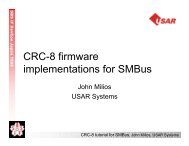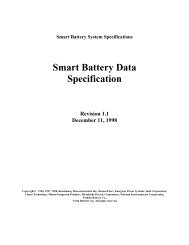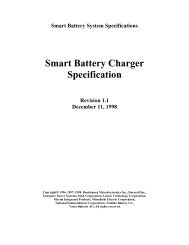Smart Battery System Manager Specification, version 1.0
Smart Battery System Manager Specification, version 1.0
Smart Battery System Manager Specification, version 1.0
You also want an ePaper? Increase the reach of your titles
YUMPU automatically turns print PDFs into web optimized ePapers that Google loves.
<strong>Smart</strong> <strong>Battery</strong> <strong>System</strong> <strong>Manager</strong> <strong>Specification</strong>During Simultaneous discharge, the SBSM should appear to the system host as either one battery orindividual batteries if specific information is requested or directed to or from a particular battery. Thisrequirement appears across the entire <strong>Smart</strong> <strong>Battery</strong> data set. Individual implementations may change thealgorithms used to combine or merge data. The SBSM interface provides the means to access either thecombined data or individual data.Examples of battery data composition may be the MaxError() command. If the system host requestsMaxError() and the SBSM is in a mode where battery composition is operating, the specific implementationmay choose to report the RMS (root mean squared value of all MaxError() values.4.5.2. <strong>Smart</strong> <strong>Battery</strong> <strong>System</strong> <strong>Manager</strong> Data Caching GuidelinesIn order to preserve bandwidth on the system host SMBus, the SBSM may employ a cache for dynamic andstatic composite battery data. Dynamic data values are those that change or are expected to change duringthe mobile PC operation, e.g., Current(). Static values are those that remain the same as long as the batteryis not removed or replaced, e.g., SerialNumber().In order to preserve data integrity and currency, the SBSM needs to apply reasonable refresh rules to anycached values. Generally stated these rules are:• Static values may be cached and re-read without limit as long as the SBSM has not been reset or thebattery exchanged, removed or newly inserted. In any of these cases, the SBSM must refresh the staticdata in any cache it may maintain and notify the system host as advised in earlier in this specification.• Dynamic data values may be cached in expectation of a system host request. Dynamic data must berefreshed after being read once. Further, the SBSM must flag an error (not respond or indicate staledata) or use any mechanism available in the physical layer to avoid or delay the response until freshdata is available and combined according to the implementation algorithm rules.• The SBSM must refresh dynamic data at appropriate intervals suggested in the following table so thatdata is not stale. The timeout period for this refresh is governed by specific OEM implementations.The following table is a guide to what battery data should be cached and when the cache should beinvalidated or updated.Function Access Composite Cacheable CacheInvalidate (inaddition tobatteryinsertion)ManufacturerAccess r/w no NoRemainingCapacityAlarm* r/w yes Yes On writeRemainingTimeAlarm* r/w yes Yes On write<strong>Battery</strong>Mode r/w yes Yes On writeAtRate r/w yes Yes On writeAtRateTimeToFull r no Yes Write to AtRate or 1minute (chargeonly)AtRateTimeToEmpty* r yes (dischargeonly)AtRateOK* r yes (dischargeonly)Yes Write to AtRate or 1minute (dischargeonly)NoCache Update(next accessOR …)SBS Implementers Forum Page 9 Revision <strong>1.0</strong>




